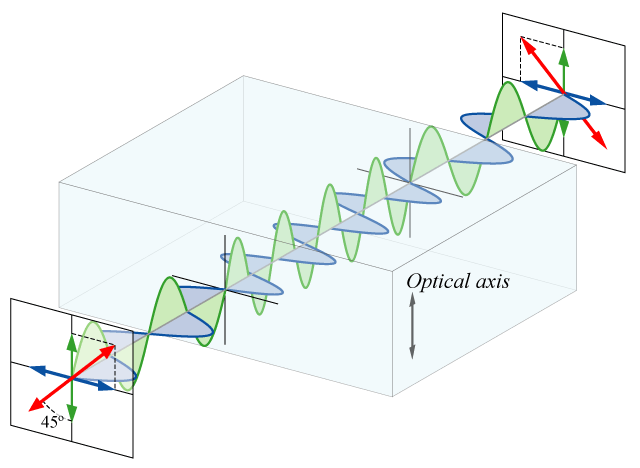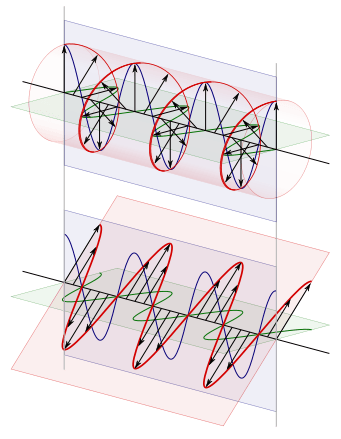The key difference between half wave plate and quarter wave plate is that half wave plate tends to shift the polarization direction of linearly polarized light, whereas quarter wave plate tends to convert linearly polarized light into circularly polarized light.
Wave plate or a retarder can be defined as an optical device that can alter the polarization state of a light wave that is travelling through it. Typically, a wave plate is made from a birefringent material including quartz, mica, or plastic. Here, the index of refraction of light linearly polarized differs from that of the other two certain perpendicular crystal axes. There are two common wave plates: half-wave plate and quarter-wave plate.
CONTENT
1. Overview and Key Difference
2. What is a Half Wave Plate
3. What is a Quarter Wave Plate
4. Half Wave Plate vs Quarter Wave Plate in Tabular Form
5. Summary – Half Wave Plate vs Quarter Wave Plate
What is Half Wave Plate?
A half wave plate tends to shift the polarization direction of linearly polarized light. When considering a linearly polarized light, a half wave plate refers to the effect of the half wave plate that rotates the polarization vector at an angle of 2θ. However, if we consider an elliptically polarized light, the half wave plate shows the effect of inverting the handedness of the light.

Figure 01: Half Wave Plate
For a half wave plate, we can use a relationship between L (thickness of the crystal), Δn (birefringence, the double refraction of light in a transparent, molecularly ordered material), and λ0 (vacuum wavelength of the light). The relationship is as follows:
Г= 2πΔnL/ λ0
Г is the amount of relative phase. For a half wave plate, the phase shift between polarization components can be given as Г=π.
What is Quarter Wave Plate?
A quarter wave plate converts a linearly polarized light into circularly polarized light and vice versa. This type of wave plate is useful in producing an elliptical polarization as well.

Figure 02: Two Waves that Differ from Each Other by a Quarter-Phase Shift for One Axis
In this type of wave plate, the polarization of the incoming photon is resolved into two polarizations at the x and y axis. Moreover, in this type of wave plate, the input polarization is parallel to the fast or slow axis. This results in no polarization of the other axis; thus, the output polarization is similar to the input. If the input polarization is about 45 degrees to the fast and slow axis, polarization tends to be equal at those axes.
What is the Difference Between Half Wave Plate and Quarter Wave Plate?
Wave plate can be defined as an optical device that can alter the polarization state of a light wave that is travelling through it. The key difference between half wave plate and quarter wave plate is that half wave plate tends to shift the polarization direction of linearly polarized light, whereas quarter wave plate tends to convert linearly polarized lift into circularly polarized light. In addition, in half wave plate, the difference between two emerging plane polarized waves is the value of pi, whereas in quarter wave plate, it is half of the pi value.
The following table summarizes the difference between half wave plate and quarter wave plate in tabular form for side by side comparison.
Summary – Half Wave Plate vs Quarter Wave Plate
Wave plate is an optical device that can alter the polarization state of a light wave that is travelling through it. There are two common wave plates: half-wave plate and quarter wave plate. The key difference between half wave plate and quarter wave plate is that half wave plate tends to shift the polarization direction of linearly polarized light, whereas quarter wave plate tends to convert linearly polarized lift into circularly polarized light.
Reference:
1. “Waveplates.” Mounted Zero-Order Half-Wave Plates.
Image Courtesy:
1. “Waveplate” (CC BY-SA 3.0) via Commons Wikimedia
2. “Circular.Polarization.Circularly.Polarized.Light And.Linearly.Polarized.Light.Comparison” By Dave3457 – Own work (Public Domain) via Commons Wikimedia
ncG1vNJzZmivp6x7pbXFn5yrnZ6YsqOx07CcnqZemLyue9ahmK1lmah6tbTEZpuinpaav6a6wp5km52krLKmuoyhmKWeXayut7GMqaOarJVirq%2BwjKqsmqqkmr9uw8CvnGaonJbBpns%3D